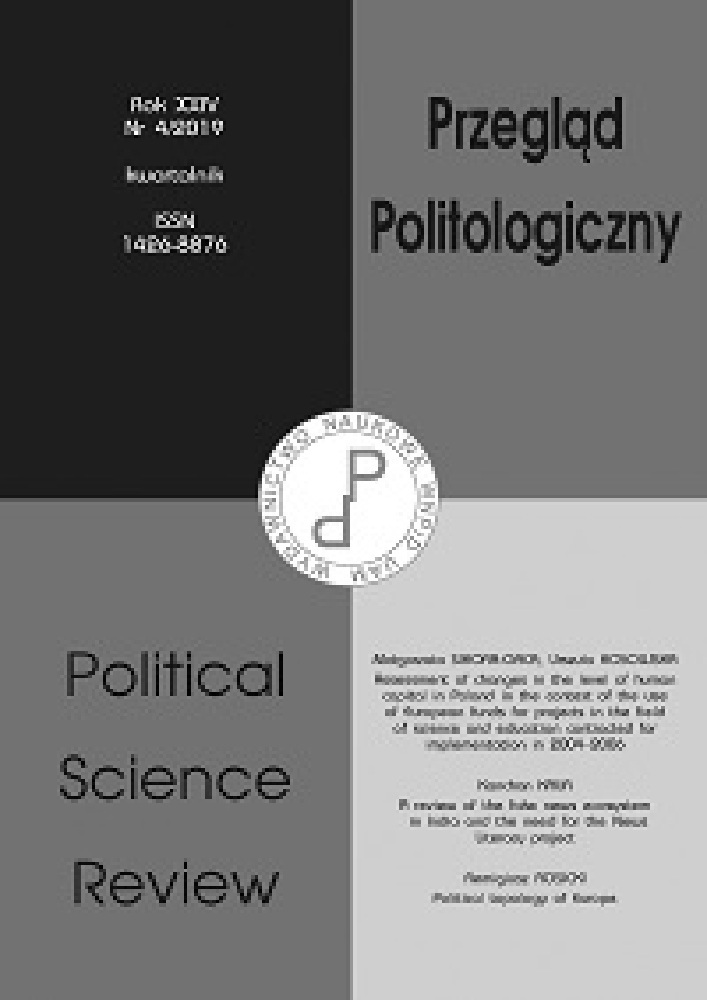Abstract
In India, in the last year alone, over 30 people have died due to child kidnapping rumors spread on social media, specifically WhatsApp. India’s access to the internet shot up in the recent years with the entry of Reliance Jio which made data plans affordable and therefore accessible. WhatsApp has been the most frequently downloaded application. As the country gears up for an important election, the spread of disinformation has accelerated. The right-wing ruling party has claimed that it has over 3 million people in its WhatsApp groups. A recent study by BBC has shown that in the country, most of the disinformation has been spread by the right wing. Call it propaganda, disinformation or plain fake news, false or wrong information has become a part of the political process in India. Moreover, the Indian media no longer seem to be standing up to the government; in the last few years, it has generally toed the government line. The reasons are many, including corporate ownership, regressive laws, and a complete bypass of the media by the powers. The Prime Minister has spoken only to a few selected media houses and has never been asked any tough questions in his five-year tenure. Furthermore, the media has been completely sidelined by this government by it going to the public, directly through social media. All of this has produced a very turgid and messy information situation. With the government also interfering in education, it has become all the more difficult for most educators to introduce critical thinking courses in the country, even though various efforts have been made by Google News Initiative, Facebook and BBC Schools to introduce tools to debunk false information.
References
Agrawal A. (2015), Why we keep calling you Presstitutes: A message from the rest of us, 18.12.2015, Scroll.in, https://scroll.in/article/776386/why-we-keep-calling-you-presstitutes-a-message-from-the-rest-of-us, 28.06.2019.
Bulger M., Davison P. (2018), The Promises, Challenges, and Futures of Media Literacy, Data & Society, https://datasociety.net/pubs/oh/DataAndSociety_Media_Literacy_2018.pdf, 30.06.2019.
Centre For News Literacy, What Is News Literacy?, Stony Brook University School Of Journalism, https://www.centerfornewsliteracy.org/, 30.06.2019.
Chakrabarti S. (2018), Nationalism a driving force behind fake news in India, research shows, 12.11.2018, BBC News, https://www.bbc.com/news/world-46146877, 25.06.2019.
Chakrabarti S., Duty, Identity, Credibility, Fake news and the ordinary citizen in India, BBC News, http://downloads.bbc.co.uk/mediacentre/duty-identity-credibility.pdf, 27.06.2019.
Correspondent (2017), Rewriting history: Akbar lost to Maharana Pratap; Mahatma, Nehru missing from texts, 25.07.2017, “Hindustan Times”, https://www.hindustantimes.com/india-news/rewriting-history-akbar-lost-to-maharana-pratap-no-mahatma-or-nehru-in-texts/story-N0xOT7Pqq6XGEvAgFXnBvI.html, 30.06.2019.
Ericsson, Future mobile data usage and traffic growth, ericsson.com, https://www.ericsson.com/en/mobility-report/future-mobile-data-usage-and-traffic-growth, 24.06.2019.
FM Staff (2019), Rise Of Hatred And Violence Linked To Fake News, 22.01.2019, “Focus magazine”, https://www.focusmagazine.in/rise-of-hatred-and-violence-linked-to-fake-news/, 28.06.2019.
Ghosh D. (2019), Elections 2019: Press Conference That Wasn’t? PM Narendra Modi Lets Amit Shah Do The Talking, 18.05.2019, NDTV, https://www.ndtv.com/india-news/elections-2019-pm-narendra-modi-addresses-first-press-conference-2039109, 29.06.2019.
Iqbal M. (2019), WhatsApp Revenue and Usage Statistics, 19.02.2019, BusinessofApps, https://www.businessofapps.com/data/whatsapp-statistics/, 26.06.2019.
Kaushik K. (2016), The Big Five: The Media Companies That the Modi Government Must Scrutinise To Fulfill its Promise of Ending Crony Capitalism, 19.01.2016, “The Caravan”, https://caravanmagazine.in/vantage/the-big-five-the-media-companies-that-the-modi-government-must-scrutinise-to-fulfill-its-promise-of-ending-crony-capitalism, 28.06.2019.
Media Ownership Monitor (2019), Who owns the media in India?, 31.05.2019, Reporters Without Borders, https://rsf.org/en/news/media-ownership-monitor-who-owns-media-india, 27.06.2019.
Meeker M. (2018), Internet Trends Report 2018, 30.05.2018, Kleiner Perkins, https://www.kleinerperkins.com/perspectives/internet-trends-report-2018/, 26.06.2019.
Mitter S. (2019), India leads the world in time spent on video-streaming apps, Netflix most downloaded paid app, 18.01.2019, YourStory, https://yourstory.com/2019/01/india-netflix-top-paid-app, 25.06.2019.
Mobility Report, June 2019, https://www.ericsson.com/en/press-releases/2019/6/ericsson-mobility-report-5g-uptake-even-faster-than-expected, 12.07.2019.
Office of the Registrar General and Census Commissioner, India 2001, Census Data Census And You/Literacy And Level of Education, http://censusindia.gov.in/Census_And_You/literacy_and_level_of_education.aspx, 27.06.2019.
Owen L. H. Can we keep media literacy from becoming a partisan concept like fact checking?, 23.02.2018, NiemanLab, https://www.niemanlab.org/2018/02/can-we-keep-media-literacy-from-becoming-a-partisan-concept-like-fact-checking/, 29.06.2019.
Press Trust of India (2018), India’s mobile subscriber base to touch 1.42 billion by 2024, 80% to use 4G, 27.11.2018, “The Economic Times”, https://economictimes.indiatimes.com/telecom/indias-mobile-subscriber-base-to-touch-1-42-billion-by-2024-80-to-use-4g/articleshow/66830785.cms?from=mdr, 24.06.2019.
Press Trust of India (2019), Facebook expands fact-checking network in India, adds 5 more partners to spot fake news, 11.02.2019, “The Economic Times”, https://economictimes.indiatimes.com/tech/internet/facebook-expanding-fact-checking-in-india-before-election/articleshow/67940960.cms?from=mdr, 29.06.2019.
Press Trust of India (2019), India drops down on World Press Freedom Index, 18.04.2019, “The Economic Times”, https://economictimes.indiatimes.com/news/politics-and-nation/india-drops-down-on-world-press-freedom-index/articleshow/68940683.cms, 29.06.2019.
Saldanha A., Rajput P., Hazare J. (2018), Child-Lifting Rumours: 33 Killed In 69 Mob Attacks Since Jan 2017. Before That Only 1 Attack In 2012, 9.07.2018, IndiaSpend, https://www.indiaspend.com/child-lifting-rumours-33-killed-in-69-mob-attacks-since-jan-2017-before-that-only-1-attack-in-2012-2012/, 25.06.2019.
Soni A. (2017), India: Using Legal Action to Silence Journalists, 10.08.2017, Global Investigative Journalism Network, https://gijn.org/2017/08/10/paranjoy-guha-thakurta-using-legal-action-to-silence-journalists/, 29.06.2019.
Special Correspondent (2018), Indian journalism going through its worst phase, 16.07.2018, “The Hindu”, https://www.thehindu.com/news/national/karnataka/indian-journalism-going-through-its-worst-phase/article24430376.ece, 30.06.2019.
Special Correspondent (2019), At 9.8 GB per month, India has the highest data usage per smartphone, 20.06.2019, “The Hindu”, https://www.thehindu.com/business/Industry/india-has-highest-data-usage-report/article28078254.ece, 24.06.2019.
Sydow L. (2019), The State of Mobile in 2019 – The Most Important Trends to Know, 16.01.2019, App Annie-Blog, https://www.appannie.com/en/insights/market-data/the-state-of-mobile-2019/, 27.06.2019.
The Economis Times, April 18, 2018, https://economictimes.indiatimes.com/news/politics-and-nation/india-drops-down-on-world-press-freedom-index/articleshow/68940683.cms, 30.06.1919.

